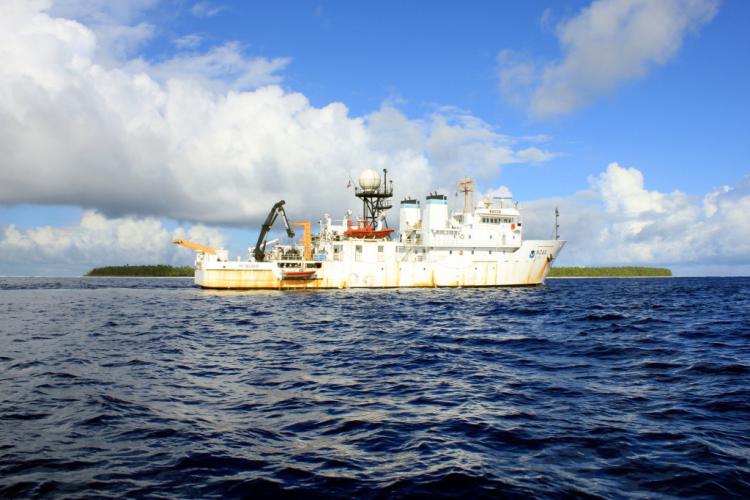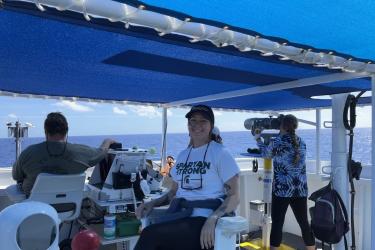We have been surveying coral reef ecosystems in the Pacific since the early 2000s. We collect data to assess how coral reefs vary over space and time. We do this to inform the management of these stunning and important ecosystems, which are packed full of biodiversity and provide coastal protection, food, and livelihoods to millions of people worldwide. During this expedition, we will survey the Pacific Remote Islands and the islands of American Samoa. Follow our progress as we post photos to share what we see while at sea!
Transit

It's smooth sailing for now as the team heads from Honolulu towards Howland Island. (Photo: NOAA Fisheries/Morgan Winston)
Field Preparation

Scientists Ari Halperin and Hannah Barkley prep equipment that will be used by the ocean and climate change team at Howland Island. We will fill these bottles with water samples to measure dissolved inorganic carbon composition in the ocean. After 7 days of transit, the team is ready to get in the water! (Photo: NOAA Fisheries/Noah Pomeroy)
U.S. Fish & Wildlife Drop-off

The U.S. Fish & Wildlife team makes it to Howland Island to unload their gear. The team will be camping on the island while the other scientists conduct our underwater surveys. (Photo: NOAA Fisheries/Tate Wester)
Documenting the Reef
Counting Fish

A school of purple anthias hover above the coral and make for a tough job of counting each one! (Photo: NOAA Fisheries/Jeffrey Milisen)
Measuring Coral

A scientist measures coral colonies along a transect of Baker Island's lively reef slopes. (Photo: NOAA Fisheries/Morgan Winston)
Sunny Shallows

Corals thrive and support a wide diversity of reef fish in the sunny, shallow water at Baker reef. (Photo: NOAA Fisheries/Morgan Winston)
Teamwork
Schooling Jacks

A school of black jacks swim through a field of branching Acropora corals at Baker Island, where scientists were recording data. (Photo: NOAA Fisheries/Jeffrey Milisen)
Coral Coring

Scientists work carefully to extract a core of skeleton from a coral head. This core acts as a record, allowing scientists back in the lab to learn more about the coral's history and possible ocean conditions over time. (Photo: NOAA Fisheries/Hannah Barkley)
Friendly Shark

A curious juvenile gray reef shark comes in for a closer look during a fish count at Swains Island. These top predators are an important part of a healthy ecosystem. (Photo: NOAA Fisheries/Jeff Milisen)
Barracuda!

Blackfin barracuda school and swarm around Swains Island. These predators usually stick together in big schools during the day, unlike the great barracuda (a similar species), which prefers to cruise around by itself. (Photo: NOAA Fisheries/Jeff Milisen)
Start of 2nd Leg

Scientists are rested and boats are fueled. They are ready to start surveying the island of Tutuila. (Photo: NOAA Fisheries)
Take Cover!

The scientist start off leg 2 jumping right in the water! Off the coast of Tutuila, juvenile orangefin dascyllus hover around a sea anenome. These little damselfishes hang around anemones or branching coral colonies for protection from predators or curious divers. (Photo: NOAA Fisheries/Louise Giuseffi)
Who's There?

This is a decorator crab, one of the little creatures found in autonomous reef monitoring structures. They have sticky hair to attach algae on their bodies and to blend in with their habitat. (Photo: NOAA Fisheries/Evan Barba)
Hang On!

Scientists hang on as the small boat "Metal Shark" transits into rougher weather on the way to one of their permanent sites. We experience many conditions out here, including rain showers and rainbows! (Photo: NOAA Fisheries/Evan Barba)
Aggressive Fish

This territorial damselfish, the jewel damsel, has bright blue iridescent spots along its body. These fish "farm" algae plots and are very territorial, darting after other fish and even divers, warning them to stay away from their food source. (Photo: NOAA Fisheries/Tate Wester)
Sea Critters

Here's a sample of some of the small sea creatures we find in the autonomous reef monitoring structures. We find crabs, snails, nudibranchs, and shrimps, just to name a few! (Photo: NOAA Fisheries/Evan Barba)
Camouflage

This goby has markings that help it blend in with its surroundings, making it hard to distinguish it from the sand. This camouflage helps it escape predators. (Photo: NOAA Fisheries/Louise Giuseffi)
Safety First!

A scientist checks his dive computer during his ascent's safety stop while diving off the coast of Tutuila. After an hour or so on the reef conducting surveys, the scientists spend three minutes at 15 feet below the surface so that they can adjust to the pressure. (Photo: NOAA Fisheries/Evan Barba)
Still Predator

An arc-eye hawk fish perches on a Pocillopora coral. These predators lie in wait for unsuspecting small fishes and crustaceans to swim by, but if something bigger shows up, they are quick to dart into the safety of the coral branches. (Photo: NOAA Fisheries/Ari Halperin)
Small Boats

Scientists come back to the ship after a day of counting and measuring corals at Ofu and Olosega islands. These davits will bring the small boat safely back to its cradle where it will be locked down for the night. Everyone was excited to see the sun again after nine days of rain and wind! (Photo: NOAA Fisheries/Evan Barba)
Backreef

Ofu Island's backreef as a wave crests over the corals. (Photo: NOAA Fisheries/Evan Barba)
Nudibranchs

This sea slug, or nudibranch, has a "naked gill" structure—a breathing apparatus outside of its body. Because they are so delicate, nudibranchs are brightly colored and sometimes toxic to deter predators. (Photo: NOAA Fisheries/Evan Barba)
Jellyfish

This invertebrate pulses through the water above the reef at Ofu Island. (Photo: NOAA Fisheries/Kaylyn McCoy)
Big Momma

A scientist dives around "Big Momma," a giant coral head off the west side of Tau Island. Scientists have estimated that this coral colony is more than 750 years old! (Photo: NOAA Fisheries/Evan Barba)
Coral Captured
Rosy Rose Atoll

The reef at Rose Atoll is covered in crustose coralline algae—a calcifying algae that can be pink and purple. The oceanographic conditions here are just right for this algae to build its calcium skeleton and thrive. It can even survive after being exposed during low tide. (Photo: NOAA Fisheries/Samantha Clements)
Towering Algae

Here is an underwater shot of crustose coralline algae. Usually it hugs the substrate, but with these superb growing conditions, it grows up! (Photo: NOAA Fisheries/Kaylyn McCoy)
Tiny Fishes

A coral head inside the protected lagoon at Rose Atoll. This protected area makes a great habitat for small fish to grow. (Photo: NOAA Fisheries/Louise Giuseffi)
On Patrol

This blacktip reef shark cruises the shallows inside the lagoon at Rose Atoll. Sometimes they come in so shallow that their dorsal fins and tails are visible from shore. (Photo: NOAA Fisheries/Evan Barba)
Reef Recyclers

This elaborate sea cucumber eats detritus and organic matter off of the sand and recycles it as nutrient output for the reefs. (Photo: NOAA Fisheries/Evan Barba)
Refueling

The NOAA Ship Hi'ialakai has concluded operations for leg 2 of her ASRAMP journey! The ship ties up at the fuel pier back in Tutuila to take on gasoline and food stores before heading off on leg 3 to the Line Islands. Be sure to check back for the journey back to Honolulu! (Photo: NOAA Fisheries/Kaylyn McCoy)
Tofa!

Tofa means goodbye in Samoan. NOAA Ship Hi'ialakai departs Tutuila on a beautiful calm morning for Jarvis Island, and will arrive in 5 days. Happy sailing! (Photo: NOAA Fisheries/Kaylyn McCoy)
Manta

NOAA Ship Hi'ialakai arrived at Jarvis Island, and scientists jumped right back in the water. Here is a shot of a scientist encountering a manta ray during the fish survey. (Photo: NOAA Fisheries/Rebecca Weible)
Swapping Out

After we soak them in ocean for 3 years, we ready the autonomous reef monitoring structures (ARMS) in yellow crates for pick-up. (Photo: NOAA Fisheries/Jeff Milisen)
Tracking Temperature through Time

Scientists swap out an underwater temperature logger that has been recording data for three years at Jarvis Island. This logger was recording during the largest warming event yet observed on a coral reef (2015 El Nino). Using many of these instruments around Jarvis at different depths allows us to gauge how thermal exposure drives change in the reef community. (Photo: NOAA Fisheries/Jeff Milisen)
Manta Fly By

A manta ray supervises as scientist Ariel Halperin flies a camera rig to capture hundreds of images that will be stitched together into a 3D model of the reef. (Photo: NOAA Fisheries/Courtney Klepac)
A Search for Corals

Benthic divers survey the coral reef for signs of new life after the catastrophic coral die-off in 2015. While the coral skeletons still stand, they are now covered in pink calcareous algae. Scientists hope to find juvenile corals growing among these remnants. (Photo: NOAA Fisheries/Courtney Couch and Brittany Huntington)
Abundant Herbivores

Thousands of convict tangs school in the shallows off Jarvis Island. These grazers travel over the reef, eating algae as they go. When these enormous schools cruise through a survey area, fish team divers have the challenging task of sizing and counting them. (Photo: NOAA Fisheries/Courtney Couch)
Teeming with Life

During the divers' descent to their survey site, a group of dolphins came by to investigate the newcomers. (Photo: NOAA Fisheries/Morgan Winston)
Palmyra Atoll

The NOAA Ship Hi'ialakai has trekked further north in the Pacific Ocean, getting closer to Hawaiian Islands. Scientists dove at the Palmyra Atoll, the northern tip of the Line Island chain, next to Kingman Reef. Here is a shot of the western terrace reef of the atoll. (Photo: NOAA Fisheries/Chelsie Counsell)
Seeing Clearly

This little clear-shell shrimp was found in one of our autonomous reef monitoring structures (ARMS) at Palmyra Atoll. (Photo: NOAA Fisheries/Evan Barba)
Running into You

An eel and snapper look like they are about to start dueling. (Photo: NOAA Fisheries/Louise Giuseffi)
Snapper Face Off

A territorial snapper comes in close to face off with our survey diver. Fishermen may avoid, and some countries even prohibit, catching this species due to ciguatera poisoning—a toxin produced by dinoflagellates that can accumulate in reef fish organs. (Photo: NOAA Fisheries/Andrew Gray)
Acropora Sunburst

Acropora corals grow up toward the sunlight to form beautiful, massive tables in Palmyra’s waters. (Photo: NOAA Fisheries/Jeff Milisen)
Hairy Crab

This crab regenerates both his shell and a new set of spikey chetae (hairs) every time he molts. (Photo: NOAA Fisheries/Evan Barba)
Clam Gardens

Giant clams abound in the shallow, lagoonal waters at Kingman Reef. An impressive array of colors and patterns can be found in a small area of reef. (Photo: NOAA Fisheries/Ari Halperin)
Gray Reef Shark

Chief Scientist, Kaylyn McCoy, counts fishes large and small during her census of fish biomass and biodiversity. This curious gray reef shark, <i>Carcharhinus amblrhynchos</i>, comes in for a closer inspection of this newcomer to his waters. (Photo: NOAA Fisheries/Jeff Milisen)
Damselfish and Anemone

A juvenile Orangefin Dascyllus damselfish (Dasacyllus auripinnis) claims this large anemone as his home. This species is found only in the Line and Phoenix Islands. (Photo: Rebecca Weible)
Rainbow Hi'ialakai

After 14 diving days across Jarvis, Palmyra, and Kingman reefs, the NOAA Ship Hi’ialakai heads home to Honolulu. (Photo: NOAA Fisheries/Courtney Couch)
Sweet Home

The NOAA Ship Hi'ialakai has returned to Honolulu, concluding her 2.5-month expedition to the Pacific Remote Islands and American Samoa. (Photo: NOAA Fisheries/Tomoko Acoba)




